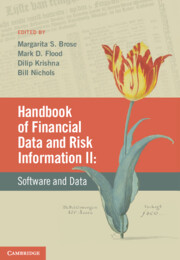Book contents
- Frontmatter
- Contents
- List of contributors
- Preface
- VOLUME II: SOFTWARE AND DATA
- PART IV DATA OPERATIONS IN FINANCIAL INSTITUTIONS
- 15 Financial market participants
- 16 Functional model for financial data and risk information
- 17 Financial institutions' data requirements
- 18 US residential-mortgage transfer systems: a data-management crisis
- PART V DATA MANAGEMENT TECHNOLOGIES
- PART VI IMPLEMENTATION OF DATA AND ANALYTICS PROGRAMS
- Index – Volume II
17 - Financial institutions' data requirements
from PART IV - DATA OPERATIONS IN FINANCIAL INSTITUTIONS
- Frontmatter
- Contents
- List of contributors
- Preface
- VOLUME II: SOFTWARE AND DATA
- PART IV DATA OPERATIONS IN FINANCIAL INSTITUTIONS
- 15 Financial market participants
- 16 Functional model for financial data and risk information
- 17 Financial institutions' data requirements
- 18 US residential-mortgage transfer systems: a data-management crisis
- PART V DATA MANAGEMENT TECHNOLOGIES
- PART VI IMPLEMENTATION OF DATA AND ANALYTICS PROGRAMS
- Index – Volume II
Summary
Summary
Data are at the very heart of the financial industry both as a critical input to business processes and as an output from them. “Precise data content is the core factor of input into virtually every business process as well as the essential ingredient for the objectives of transparency and regulatory oversight.” Driven by regulations, compliance, client reporting, operational efficiency and a host of other imperatives, data management has become a strategic priority for Financial Institutions (FIs). The signing of the Dodd–Frank Wall Street Reform and Consumer Protection Act on July 21, 2010 in the USA and the emerging Basel Committee on Banking Supervision framework for liquidity risk management furthered the challenges FIs face and accelerated the need for strong data management governance across the enterprise. The regulations have created a fundamental shift towards enterprise-wide data where FIs now have to report business fundamentals, like cash flows, across all asset classes, geographies, legal entities and more.
Enterprise data comprises centralized, accurate and transparent datasets that are modeled to be consistent with all uses of the data, in all business processes. It should be based off industry standards to allow accurate communication with all regulators and counterparties. Standardized processes for the creation, enrichment and management of the dataset are the cornerstone of enterprise data. Robust data architecture to support distribution and integration is another pillar.
- Type
- Chapter
- Information
- Handbook of Financial Data and Risk Information IISoftware and Data, pp. 50 - 84Publisher: Cambridge University PressPrint publication year: 2014
- 1
- Cited by



